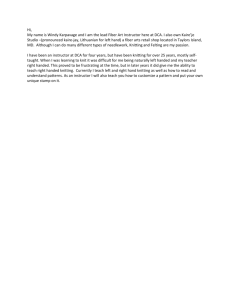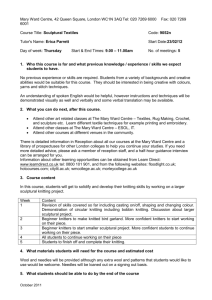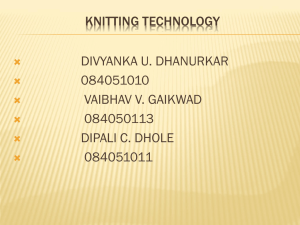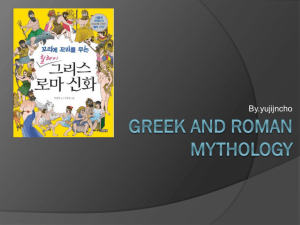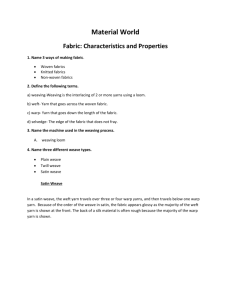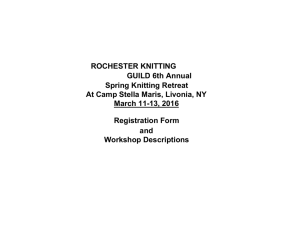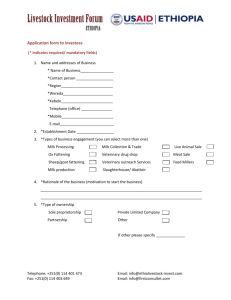Project profile on knitting mill
advertisement
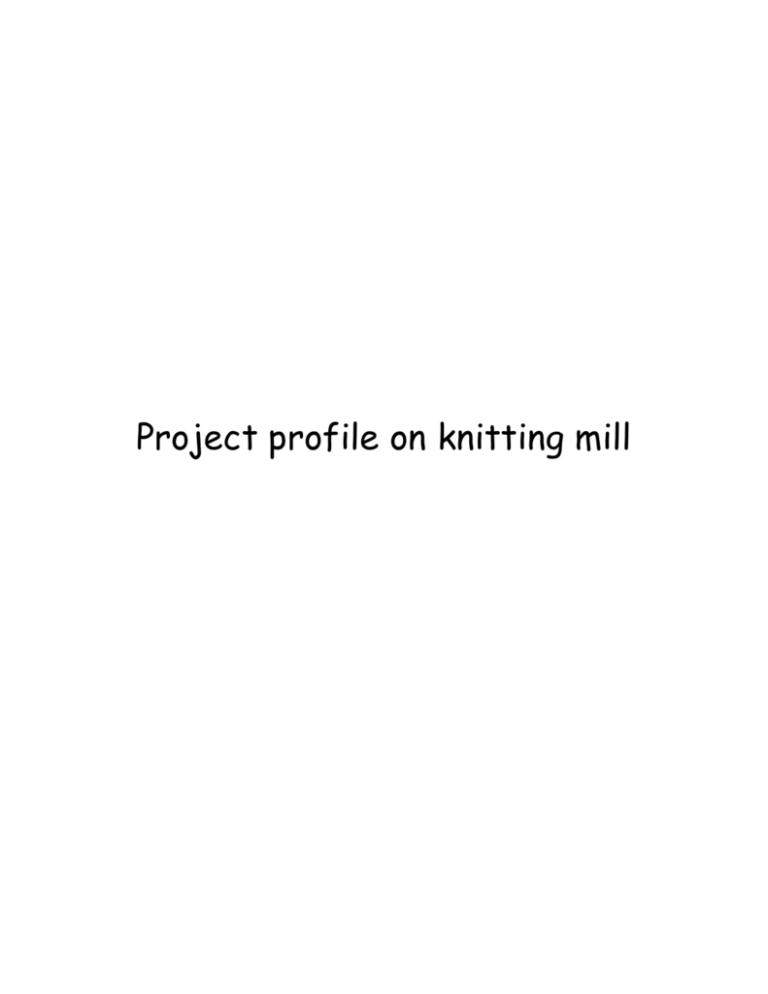
Project profile on knitting mill Table of Contents 1. Executive Summary......................................................................................2 2. Product Description and Application...........................................................3 3. Market Study, Plant Capacity and Production Program...............................3 3.1 Market Study..................................................................................3 3.1.1 Present Demand and Supply...............................................3 3.1.2 Projected Demand.............................................................5 3.1.3 Pricing and Distribution.....................................................6 3.2 Plant Capacity and production capacity..........................................7 4. Raw Materials and Utilities ........................................................................8 4.1 Availability and Source of Raw Materials.......................................8 4.2 Annual Requirement and Cost of Raw Materials and Utilities........9 5. Location and Site.........................................................................................10 6. Technology and Engineering.........................................................................10 6.1 Production Process...........................................................................11 6.2 Machinery and Equipment ..............................................................13 6.3 Civil Engineering Cost......................................................................15 7. Human Resource and Training Requirement ................................................17 8. Financial Analysis.........................................................................................18 8.1 Underlying Assumption....................................................................18 8.2 Investment.....................................................................................19 8.3 Production Costs.............................................................................20 8.4 Financial Evaluation.........................................................................21 1 1. Executive Summery This project profile envisions the founding of a plant for the production of weft knitted fabrics with a capacity of 5125 tons per annum. The plant is intended to sell 100 % of its product to the international market so that it could earn foreign currency to the country and able to reach the vast market opportunity for project promoter. The present demand for the proposed weft knitted fabric is estimated at 21,304 tons per annum. The demand for weft knitted fabric is likely to reach at 123,031 tons per year by the year 2015 based on the projection made on the five year growth and transformation plan of Ethiopian textile sector. The total investment requirement is estimated at Birr 169,860,469 Birr, out of which 38.2% is required for plant and machinery, 32.67 % is for working capital, 17.52% for building and civil work and the rest 11.7 is expend for office eq. The project will create employment opportunity for 136 people. The project is financially viable that it will reach breakeven point at 20% of the capacity and has a payback period of 2 years. Generally, the project has a backward linkage effect with the yarn industries and forward linkage with the knitted fabric finishing and garment manufacturing industries. The establishment of such factory will have a foreign exchange saving and earning effect to the country by substituting the current imports and by exporting to the world market. 2 2. Product description and application Weft knitting is a method of forming a fabric in which the yarn loops are made in horizontal way from a single yarn and intermeshing of loops take place in a circular or flat form in across wise basis. Compared to woven and non woven fabrics, Knitted fabrics have very good feature of flexibility in movement, mobility, elasticity and good behavior of recovery from wrinkling. Besides, knitted fabrics are quite easy for multiple designs and pattern changes. The knitted fabric structure has good absorbency makes it most comfortable to wear. It is often used for clothing such as t- shirts, socks, t- shirts gloves, shirts, sweaters, blouses, formal dresses, high fashion clothes, pajamas and underwear. Beautiful drape makes knitted fabrics appropriate for many furnishing applications like car seat cover, furniture covers and back fabric for synthetic coats. It is also used for upholstery. 3. MARKET STUDY AND PLANT CAPACITY 3.1 MARKET STUDY 3.1.1. Past Supply and Present Demand As long as an extreme attention is given to the textile manufacturing sector in the country, a number of foreign and domestic investors are launching many mechanized cotton farms, cotton ginning, spinning mills and textile industries in the country. All the incentives provided such as tax free market for textile products in economic giant continents like US and Europe, 70% by 30% Development Bank loan scheme, 80 years lease land for investors and 5 years tax free spare parts import and other 3 opportunities cheered on many investors to be drawn to the textile sector. Along with the above incentives and motivations the textile manufacturing industries are migrating to Africa and other poor countries due to the increase of labor cost in countries like Turkey, Italy and others. On the contrary, Ethiopia has relatively lower cost labor force and good source of raw material. All the listed reasons fueled the textile sector to show up dramatic change in number and influence the economy of the country. Even though, there is knitting production capacity of 11,100 tons per year1in the country, there is still bigger domestic and international knitted textile product demand (‘Then good luck, and remember the sky's the limit."). The market segment for proposed project is 100% targeted to the international market for the coming 10 years. Ethiopia has exported few amount of knitted fabric for the past 10 years despite the fact that the market for developing nations are still at large and the government had planned in the Growth and transformation plan to export textile products as it is depicted in the following table. Table 3.1 Export Market demand plan of weft knitting Year(EC) 1 Knitted fabric Export plan (In ton) knitted fabric Exported (ton) Growth Rate (%) 1996 4,444 5110.6 15.0% 1997 5,697 6551.6 15.0% 1998 7,304 8399.6 15.0% 1999 9,365 10770 15.0% 2000 12,006 13807 15.0% 2001 15,392 17701 15.0% 2002 18,108 20824 15.0% 2003 21,304 24500 15.0% [GTP plan for textile sector, TIDI 2011] and textile digest 2003 4 3. 1.2. Projected Demand During mid of 2003 Textiles Intelligence published a report "World Markets for Knitted Textiles and Apparel: Forecasts to 2010" showing that world production of knitted textiles and apparel was over 17 million tons accounting for one third of world textile market, and the output will grow by 25% over the following ten years, reaching over 21 million tons. [Source : Textile digests report, 2003]. In terms of knitwear production, a report published in January/February 2010 by juststyle shows that during 2004 to 2008, China increased its world market share in knitwear from 20% to 32% partly due to the removal of quotas and also due to the range of yarns and capabilities available. However, price of knitwear from China is relatively high. The report also reveals that currently the fastest-growing countries for knitwear are Nicaragua, Vietnam, Cambodia and Indonesia. Accordingly, an average annual growth rate of weft knitting is about 15% hence, by taking the estimated present demand as a base and applying a 15% growth rate the projected demand for the product is shown in Table 3.22 2 [GTP plan for textile sector, TIDI 2011] 5 Table 3.2 Export Market demand Projection Year(EC) Projected Demand Knitted fabric (ton Existing Capacity knitted fabric(In ton) Unsatisfied demand Lint cotton (ton) Growth Rate(%) 2003 21,304 11,100 10,204 15.82% 2004 25,309 11,100 14,209 6.22% 2005 26,989 11,100 15,889 14.05% 2006 31,399 11,100 20,299 21.93% 2007 40,219 11,100 29,119 15.00% 2008 46,252 11,100 35,152 15.00% 2009 53,190 11,100 42,090 15.00% 2010 61,168 11,100 50,068 15.00% 2011 70,343 11,100 59,243 15.00% 2012 80,895 11,100 69,795 15.00% 2013 93,029 11,100 81,929 15.00% 2014 106,983 11,100 95,883 15.00% 2015 123,031 11,100 111,931 15.00% As revealed by the data set in Table 3.2, Weft knitting fabric consumption had exhibited an average annual growth of 15% during the years 1996 to 2003. Assuming the same growth trend will increase to 15%, the future demand for cotton yarn is projected to range from 21,304 tons in year 2003 to 123031 tons by the year 2015. The unsatisfied local market demand by the year 2015 is determined to be 111,931 tons assuming that the existing Knitting capacity 11,100 tons is remained unchanged for the coming 10 years as it is shown in table 3.2. 3.1.3 Pricing and Distribution Based on current average price of the world Knitted fabric market price, the average price of Birr 148 Birr/ Kg is adopted for financial analysis. 6 Table 3.5 Price distribution Value addition to yarn Product Mix U/m Current price(Birr) Single Jersey kg 20% 138 45% Rib kg 40% 161 35% Interlock kg 30% 149.5 20% Average selling Price Weight (%) 148.35 3.2 Plant capacity and production program 3.2.1 Plant capacity On the basis of the projected data obtained, the weft knitting mill is supposed to produce knitted fabric from carded, combed, and dyed yarn and other textile fiber materials at a capacity of 16 tons/day and 5125 tons per annum. The knitting mill will work 320 days per annum and 24 hours per day in 3 shifts. 3.2.4 Production program The planned capacity will be achieved in the third year of the establishment year of the knitting mill. In a period of 12 months project time, the project will be realized. It is estimated that production starts at 80% plant capacity in the first year, 90% in the second year and it will continue to work with this capacity for the coming 10 years. 7 Table 3.6 Yearly Production Program Year 1 2 80 90 100 100 4096 4608 5120 5120 Capacity Utilization (%) Knitted fabric (Tons) 3 4 and above Remark: No of working days in a year is 320 4. Raw Materials and utilities 4.1 Raw Materials The main raw material required to produce the knitted fabric is raw cotton yarn. The major suppliers of these raw materials are Quality yarn manufacturing mill all over the country. There are auxiliary materials like poly bag, hessian cloth, and tie wire and etc... Table 4.1 Raw and Auxiliary materials & costs S/n Description U/M Qty Cost(Birr) A. Raw material LC FC TC 1 Combed Yarn (45%) kg 1990656 235,892,736 235,892,736 2 Dyed yarn (20%) kg 884736 104,841,216 104,841,216 3 Carded yarn (25%) kg 1105920 131,051,520 131,051,520 4 Open end yarn (10%) kg 442368 52,420,608 52,420,608 Sub Total 524,206,080 B. Auxiliary material 1 Packing materials kg 2,621,030 Sub Total 2,621,030 2,621,030 C. Miscellaneous 5,242,061 Sub Total 5,242,061 Total 532,069,171 8 4.2 Utilities Electricity, fuel and water are the three major utilities required by the envisaged plant. Total annual cost of major utility items at full operation capacity of the plant is Birr 3,066,100.Details are shown in the table below: Table 4.2 Utilities Requirement S/N Utility Requirement (Annual) Unit price 1 Electricity 3456000 kwh 0.55 Birr/Kwh 1,900,800 2 Fuel(Diesel Oil) 80,000lt 14.50 Birr/lt 1,160,000 3 Water 2000 m3 2.65 Birr/m3 5,300 Total Cost(Birr) 3,066,100 5. Location and Site Location of the plant is determined on the proximity of raw materials, availability of infrastructure, availability of skilled man power and distance to potential market outlet. In view of this, the envisaged plant will be established in Oromiya regional state in Sebeta industrial zone. 9 6. Technology and Engineering 1 Production process Knitted structures are progressively built-up from row after row of intermeshed loops. The newly-fed yarn is converted into a new loop in each needle hook. The needle then draws the new loop head first through the old (fabric) loop, which it has retained from the previous knitting cycle. The needles, at the same time, release, (cast-off or knock-over) the old loops so that they hang suspended by their heads from the feet of the new loops whose heads are still held in the hooks of the needles.3 A cohesive knitted loop structure is thus produced by a combination of the intermeshed needle loops and yarn that passes from needle loop to needle loop. Weft knitting is the more diverse, widely spread and larger of the two sectors, and accounts for approximately one quarter of the total yardage of apparel fabric compared with about one sixth for warp knitting. Weft knitting machines, particularly of the garment-length type, are attractive to small manufacturers because of their versatility, relatively low total capital costs, small floor space requirements, quick pattern and machine changing facilities, and the potential for short production runs and low stock-holding requirements of yarn and fabric. 3 Knitting Technology, David Spencer 10 Chart-1 Knitting process flow chart Yarn receipt Yarn weighing Weft knitting Circular knitting Flat knitting Plain Rib Single jersey Rib Inspection Weighing Delivery 11 Interlock 6.2 Sources of Technology The source of technology for weft knitting machines is from reputable knitting machine manufacturers such as Mayer & cie, Fukahara, Hanshin, Stoll Shima and Seiki which are originated from Germany, Japan and South Korea respectively. The reconing machine is originated from india. The utility machines are selected from the most famous and branded European manufacturer like Luwa (Switzerland), Atlascopco (Belgium) and Iveco (Italy). 6.3 Machinery and Equipment 4 The main features of the knitting machine Originally, the term ‘machine’ used to refer to a mechanism on a bearded needle frame such as the fashioning mechanism on the straight bar frame. Today, it refers to the complete assembly. A knitting machine is thus an apparatus for applying mechanical movement, either hand or power derived, to primary knitting elements, in order to convert yarn into knitted loop structures. The machine incorporates and co-ordinates the action of a number of mechanisms and devices, each performing specific functions that contribute towards the efficiency of the knitting action. The main features of a knitting machine are as follows: 1 The frame or carcass, normally free standing and either circular or rectilinear according to needle bed shape, provides the support for the majority of the machine’s mechanisms. 2 The machine control and drive system co-ordinates the power for the drive of the devices and mechanisms. 4 Knitting technology ,David Spenser 12 3 The yarn supply consists of the yarn package or beam accommodation, tensioning devices, yarn feed control and yarn feed carriers or guides. 4 The knitting system includes the knitting elements, their housing, drive and control, as well as associated pattern selection and garment-length control device (if equipped). 5 The fabric take-away mechanism includes fabric tensioning, wind-up and accommodation devices. 6 The quality control system includes stop motions, fault detectors, automatic oilers and lint removal systems. Machines may range from high-production, limited-capability models to versatile, multi-purpose models having extensive patterning capabilities. The more complex the structure being knitted, the lower the knitting speed and efficiency. The simplest of the knitting machines would be hand-powered and manipulated whereas power driven machines may be fully automatically-programmed and controlled from a computer system. 13 Table 6.1 Machinary and Equipment requirement & Cost for knitting 5 Price(Birr) S/N Description MLBF 20E, 30” Dia Fleece M/C RELANIT 4 24E, 30” Dia Single Jersey M/C INOVIT 2.0 18E, 30” Dia Inter Lock M/C FV 2.0, 16E, 30” Dia Rib M/C RELANIT 4, 28E, 26” Dia Single Jersey DXC 3S(2) 24E, 22” Dia Single Jersey M/C VXC 3S(2) 24E, 24” Dia.Single Jersey M/C. DXC 3S(2) 24E, 20” Dia Single Jersey M/C. MBF 3.2 20E, 30” Dia Fleece M/C. HB-103 52” X 14g Flat Knitting M/C HJ-118,52” X 14g Flat Knitting M/C (Jacquard ) CMT-211,84”X14g Semi Jacquard Flat Knitting M/C SFF-152T54”X14g Semi Jacquard Flat Knitting M/C Reconing M/C Compressor Air coditioning system Stand by Generator 1 2 3 4 6 7 8 9 10 11 12 13 14 15 16 17 18 Brand Mayer & Cie Mayer & Cie Mayer & Cie Mayer & Cie Mayer & Cie Origin TC(Birr) Germany Set 4 840,432 3,361,727 Germany pcs 6 1,050,540 6,303,239 Germany pcs 2 612,815 1,225,630 Germany pcs 2 542,779 542,779 Germany pcs 2 924,475 1,848,950 Fukahara Japan pcs 3 672,345 2,017,036 Fukahara Japan pcs 2 714,367 1,428,734 Fukahara Mayer & Cie Japan pcs 2 630,324 1,260,648 Germany pcs 2 1,008,518 2,017,036 Hanshin S.Korea pcs 12 864,065 10,368,778 Hanshin S. Korea pcs 4 1,920,667 7,682,669 Stoll Germany pcs 2 1,152,400 2,304,801 Shima Seiki PEAS Atlascopco Luwa Iveco Japan India Belgium Switherland Italy pcs pcs pcs pcs pcs 10 1 1 1 1 740,829 894,000 500,000 400,000 350,000 7,408,288 894,000 500,000 400,000 350,000 pcs 1 FOB Price Freight,Insurance,customs & Bank charges,Material handeling cost 49,914,315 14,974,294 Total CIF Land cost 5 U/M Qty U/p(Birr) 14,974,294 64,888,609 Machinery catalogues of knitting machine manufacturers 14 6.3. Land, building and civil work The proposed plant requires a total land area of 10000m2. The floor space required for plant building, ware house, parking lot and for other facilities. A building with single story covering an area of 3800m2 will be constructed to accommodate the production hall and office building respectively. The total estimated cost of building civil works at the rate of Birr 6,000 per m2 is Birr 29,764,800. The lease period for the land 80 years and the payment of lease prices is in 40 years. Moreover, advance payment of lease based on the type of investment is 10%.The lease price is payable after the grace period annually. Accordingly, in order to estimate the land lease cost of the project profiles it is assumed that all manufacturing projects will be located in Oromia region, industrial zone. Therefore, for this profile since it is a manufacturing project a land lease rate of Birr 6.5 Birr/M2/year is adopted. 7. Man power and training requirements 7.1 Man power requirement for operation The manpower requirement is considered at 136 personnel for various levels. This includes Casual labor, technical, supervisory staff and administrative staff. Table below, shows the list of manpower required along with annual labor cost. 15 Table 7.1 Man power Requirement of weft knitting mill Req No S/N Description Monthly salary Annual salary 1 Factory Manager 1 10,000 120,000 2 Secretary 1 3,000 36,000 3 Production and Tech Manager 1 7,500 90,000 4 Production supervisor 3 4,000 144,000 5 Mechanical maintenance supervisor 1 4,000 48,000 6 Electrical Supervisor 1 4,000 48,000 90 1,000 1,080,000 8 Mechanic 4 1,300 62,400 9 Electrician 3 1,300 46,800 11 Quality and Laboratory manager 1 7,500 90,000 12 Process testers 3 2,000 72,000 13 Marketing Manager 1 7,500 90,000 14 Administration and Finance manager 1 7,500 90,000 15 Accountant 1 5,000 60,000 16 Clerks 1 1,000 12,000 17 Cashier 1 1,200 14,400 18 Purchasers 1 1,500 18,000 19 Store Keepers 2 1,000 24,000 20 Guard 8 700 67,200 21 Messenger 1 600 7,200 22 Driver 3 800 28,800 23 Cleaner 7 600 50,400 7 Machine Operators Sub Total 2,299,200 Employee Benefit ( %) 15% 344,880 Grand Total 136 2,644,080 16 7.2 Man power requirement for Project execution Table 7.2 below, shows the list of manpower required along with annual labor cost. Total manpower needed, including skilled and unskilled labor is 30 persons. Table 7.2 Man power Requirement of knitting mill and 12 months labour cost S/N Description Req. No Monthly salary/head Annual salary 1 Project Manager 1 16,000 192,000 2 Project Engineer 1 10,000 120,000 3 Construction Forman 1 6,000 72,000 4 Electrician 2 4,000 96,000 5 Mechanics and Plumbers 2 4,000 96,000 6 Secretery 1 3,000 36,000 7 Finance and Adminstration 1 10,000 120,000 8 Acountant 1 7,000 84,000 9 Purchaser 1 5,000 60,000 1 1,500 18,000 10 2,000 240,000 12 Driver 1 1,000 12,000 13 Guard 7 1,000 84,000 10 Cashier 11 Daily Labourer Sub Total Employee Benefit( %) Grand Total 30 1,230,000 30% 369,000 1,599,000 17 7.3 Training, Design and Consultancy The total cost required for design, consultancy, training and commissioning is estimated to be Birr 3.7 million. Table 7.3 Design, consultancy ,training and test run cost S/N Description Est Budget/year(Birr) 1 Engineering,Design & consultancy fee 2,000,000 2 training 700,000 3 Comissioning and test run with 10% contingency 1,000,000 3,700,000 4 Total 8. Financial Analysis 8.1 Underlying Assumption The financial analysis of cotton yarn producing plant is based on the data provided in the preceding chapters and the following assumptions A. Construction and Finance Construction period 12 months Source of Finance 30% equity and 70% Loan from bank Tax Holidays 5 years Bank Interest rate 8.50% Discount for cash flow 8.50% Value of Land Based on the lease rate of oromiya Spare parts & Repair and Maintenance 5% of the fixed investment 18 B. Depreciation Building 5% Machinery and Equipment 10% Office Furniture 10% Vehicles 20% Pre-Production(Amortization) 20% C. Working Capital(Minimum day of coverage) Raw Material Local 30 days Raw Material Foreign 120 days Factories supplies in stock 30 days Spare part in stock and Maintenance 60 days Work in Progress 5 days Finished Product 20 days Account receivable 30 days Cash in Hand 20 days Accounts payable 30 days 8.2 Investment The investment cost of the project including working capital is estimated at Birr 170 million. The owner shall contribute 30% of the finance in the form of equity while the remaining 70% is to be financed by bank loan. 19 Table 8.1 Total Initial Investment Item LC Land Building and Civil Work FC Total 5,200,000 19,000,000 5,200,000 10,764,800 29,764,800 Office Equipment 1,200,000 1,200,000 Vehicles 8,000,000 8,000,000 Plant machinery and equipment 64,888,609 64,888,609 Total Fixed investment cost 84,853,409 109,053,409 5,299,000 5,299,000 90,152,409 114,352,409 Pre-Production(Capital Expenditure) Total initial investment cost Working capital at full capacity 55,508,060 Total 79,708,060 55,508,060 90,152,409 169,860,469 8.3 Production Cost The total production cost at full capacity operation is estimated at Birr 553.4million. Raw material and utilities accounts for 96.7%, while the rest together costs 3.3% of the total production cost. Table 8.3 Total Production cost at full capacity Items Cost 1. Raw Material 532,069,171 2.Utilities 3,066,100 3.Wages and salaries 2,644,084 4.Spares and Maintenance 2660345.855 5. Depreciation 10,905,341 6.Marketing and Promotion 2,030,000 7.Adminstrative Expense 5,320,692 Total Production cost 553,375,042 20 8.4 Financial Evaluation I. Profitability According to the projected income statement (See Annex 1) the project will generate profit beginning from the first year of operation and increases on wards. The income statement and other profitability indicators also show that the project is viable. II. Breakeven Analysis The breakeven point of the projects is given by the formula: BEP = Fixed Cost Sale –Variable Cost at full capacity. The project will break even at20 % of capacity utilization III. Payback Period Investment cost and income statement projection are used in estimating the project payback period. The projects will payback fully the initial investment less working capital in 2 years. 9. Economic and Social Benefits and Justification Based on the foregoing presentation and analysis, we can learn that the proposed project possesses wide range of benefits that complement the financial feasibility obtained earlier. In general, the envisaged project promotes the socio-economic goals and objectives stated in the growth and transformation plan of the government. A. Profit Generation The project is found to be financially viable and earns on average a profit of Birr 58.1 million per year and Birr 581 million within the project life. Such result induces the project promoters to reinvest the profit which, therefore, increases the investment magnitude in the country. 21 B. Tax Revenue In the project life under consideration, the region will collect about Birr 168million from corporate income tax. Such result create additional fund for the government that will be used in expanding social and other basic services in the region. C. Employment and Income Generation The proposed project is expected to create employment opportunity to several citizens of the country. That is, it will provide permanent employment to 136professionals as well as support stuffs. D. Pro Environment Project The proposed production process is environment friendly. 22 ANNEXES 23
